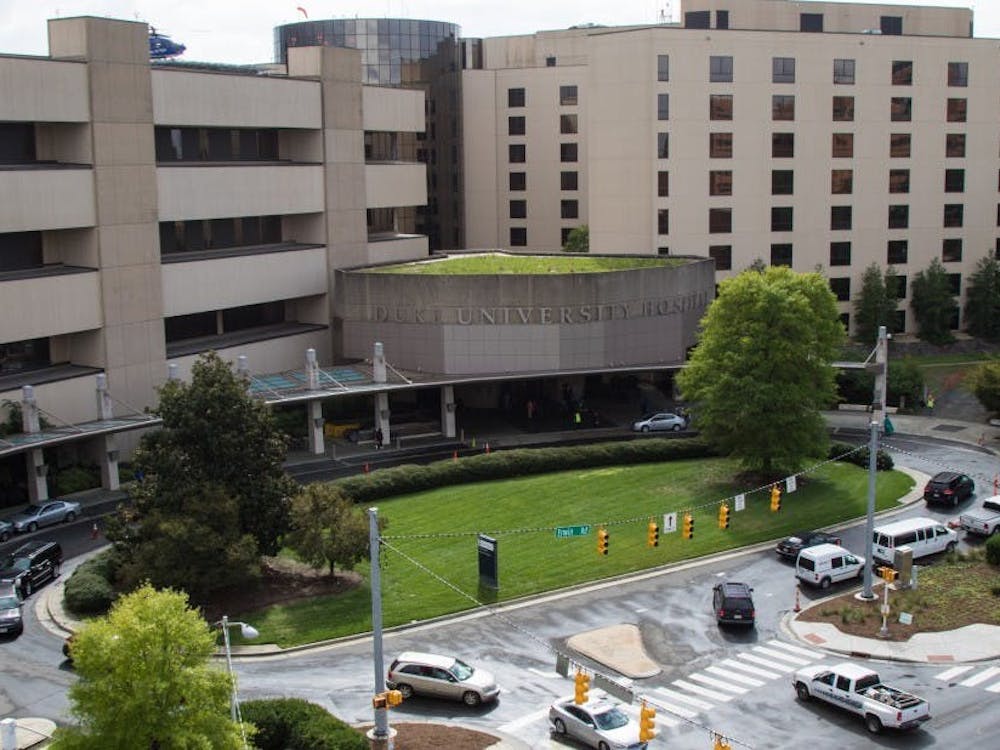Segregation in the 20th century contributed to a still-strained relationship between Durham and the Duke Hospital, two Duke professors told a virtual audience at a Tuesday event.
Damon Tweedy, author of “Black Man in a White Coat: A Doctor's Reflections on Race and Medicine” and an associate professor of psychiatry and behavioral sciences, and Jeffrey Baker, director of the Trent Center and professor of pediatrics and history, discussed Duke Hospital’s history with race and racism and the lessons Duke can take from this moving forward. The event was hosted by the Duke School of Medicine Office for Faculty and the Trent Center for Bioethics, Humanities and History of Medicine.
Tweedy began by reflecting on his own experience applying to medical school at Duke.
“One of the very first things I was told by people is that Duke is ‘the plantation,’” he said.
“Why would you go to a school that’s basically built on tobacco money, plantation money?”
He said that Duke’s complex racial history as a university in the South played a role in this perception, but acknowledged that “it’s more complicated than how it was distilled to me back then.”
Baker explained that the Duke family—which has links to slavery and likely enslaved at least one person directly—built up most of their wealth in the tobacco industry after the Civil War. Baker noted that Duke’s founding vision, especially in comparison to the rest of the South, was progressive for that time.
“The people who decided to found Duke Hospital in the 1920’s were people who considered themselves racially progressive,” he said. “They were Republicans, they were industrialists, and they established this endowment with the purpose of improving education and healthcare of people in North Carolina. That’s a pretty progressive standpoint.”
The Duke Hospital—founded in 1930—was originally envisioned as a hospital to take care of both white and Black patients, with a focus on primary care. However, this founding vision didn't necessarily translate into reality, as Baker pointed out two central barriers to racial equality during this time: Jim Crow and economics.
The hospital itself remained segregated from the 1930s to the 1960s, with separate wards for each race. Baker explained that Black and white patients had very different experiences with Duke Hospital at that time—because only white patients could be seen before noon, wait times were hours longer for Black patients. The quality of care could decrease by the time they were seen, and often Black patients would be asked to come back the next day.
Financial issues during the Great Depression also led the Duke Hospital to open a private clinic in the 1930s, with better waiting areas, appointment availability—and mostly white patients. Baker explained that the difference in patient care also became greater over time.
“When you look at the number of beds for white and Black patients in 1932, they’re the same. As you get into the 40s and 50s, as the hospital expands, it’s going to be weighted disproportionately toward insured patients as well as the private patients,” Baker said. “As that happens, there’s not as many beds for African Americans.”
These policies manifested themselves in harm to Black patients, including Maltheus Avery, a Black student at North Carolina A&T, who was involved in a serious car accident in 1950. After Duke Hospital turned him away because their Black beds were full, he was instead taken to the smaller African American hospital in Durham, where he later died.
In 1963, the Duke Hospital entered a new era when desegregation began. However, as Baker explained, “it wasn’t so much that racial segregation stopped.”
“It was sort of transformed. The Black and white wards evolved into public and private clinics,” Baker said. “In the late 60s, even into the early 70s the clinics were really different.”
As late as 1978, Baker pointed to the example of an African American physician who chose not to come to Duke for his fellowship because he was so shocked by the unacknowledged system of segregation effectively put in place by these public and private clinics.
It was also during this time period that the Duke Hospital had other difficulty recruiting Black faculty. Faculty housing remained segregated into the 1960s, and Black physicians were not able to eat in the cafeteria or to treat certain patients into the 1970s.
This history has contributed to a complex relationship with the Durham community, including both positive outreach and the legacy of Duke Hospital’s history.
“Duke has always had kind of a complicated relationship with the community,” Baker said.
Contributing to the problem of finding Duke’s role in the community, Tweedy said that “in science and medicine we’ve seen ourselves as being kind of above the fray, and not realizing the different biases that we bring to the table.”
Baker echoed this point, saying that he thinks that “we have to understand that we have come out of certain stories and backgrounds and we’re seeing patients who have come out of their own stories.”
Get The Chronicle straight to your inbox
Sign up for our weekly newsletter. Cancel at any time.
With Duke specifically, he emphasized that “institutionally, I do think Duke is really trying to learn from this past,” but that Duke needs to look to strong community partnerships and listen to individuals to repair its relationship with Durham.

